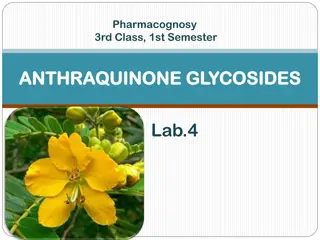Production Technology for Ornamental Crops and Landscaping - Aloe Vera Cultivation
This course covers the production technology of ornamental crops, landscaping principles, and cultivation methods for Aloe vera plants. It includes identifying different ornamental and medicinal crops, landscaping principles, uses of landscape trees, and production techniques for important ornamental crops. The focus is on Aloe vera cultivation, including soil requirements, climate preferences, land preparation, planting techniques, spacing, plant population, varieties, and propagation methods.
Download Presentation

Please find below an Image/Link to download the presentation.
The content on the website is provided AS IS for your information and personal use only. It may not be sold, licensed, or shared on other websites without obtaining consent from the author.If you encounter any issues during the download, it is possible that the publisher has removed the file from their server.
You are allowed to download the files provided on this website for personal or commercial use, subject to the condition that they are used lawfully. All files are the property of their respective owners.
The content on the website is provided AS IS for your information and personal use only. It may not be sold, licensed, or shared on other websites without obtaining consent from the author.
E N D
Presentation Transcript
Course Name- Production Technology for Ornamental Crops, MAP and Landscaping Course Code- 20014400 Presented By- Dr. Mahendra Kr. Yadav B.Sc. (Ag.) IV Sem. (Production Technology for Ornamental Crops, MAP and Landscaping)
Course Objectives Identify different types of ornamental and medicinal crops. Examine various principles of landscaping, uses of landscape trees, shrubs and climbers, production technology of important ornamental crops, etc. Determine about Demonstrate various Package of practices for loose flowers and their transportation, storage house and required condition for cut and loose flower. Construct about the various problems with the production technology of medicinal and aromatic plants. Importance of Processing and value addition in ornamental crops and MAPs produce. B.Sc. (Ag.) IV Sem. (Production Technology for Ornamental Crops, MAP and Landscaping)
Production technology of Aloe vera B.Sc. (Ag.) IV Sem. (Production Technology for Ornamental Crops, MAP and Landscaping)
Production technology of Aloe vera Botanical Name : Aloe vera or Aloe barbadensis Family : Liliaceae/Asphodelaceae Chromosome No. :2n=2x=14 Origin : Eastern and South Africa Plant Part use Leaves, roots, seeds Uses: 1. Anthelmintic-used for helminthaiases in children and used as purgative. 2. Used for local applications in painful inflammations, chronic ulcers and ophthalmic 3. Juice is used for flatulence, constipation, abdominal tumors, piles, sciatica, lumbago 4. Used for curing skin diseases and uterus disorders B.Sc. (Ag.) IV Sem. (Production Technology for Ornamental Crops, MAP and Landscaping)
Soil: Soil: Aloe is a hardy crop which can be grown on wide variety of soils. It growth well in sandy coastal and loamy soils with pH up to 8.5 water logged, problematic soils not suitable. Climate: Climate: Wide adaptability, hence cultivation is possible throughout the country and prefers dessert and dry situations. Grown in hot and dry climate with 35-40 cm annual rainfall. Land preparation and planting: The land is ploughed and cross ploughed thoroughly. Farm yard manure is added @ 15 t/ha during the last ploughing. Ridges and furrows are formed at 45 or 60cm apart. The plot may be irrigated if necessary. The suckers are planted at 40 or 30cm apart, maintaining the spacing suggested. B.Sc. (Ag.) IV Sem. (Production Technology for Ornamental Crops, MAP and Landscaping)
Spacing and plant population: Normally a spacing of 40cm x 45cm or 60cm x 30cm is followed. This accommodates about 55000 plants per hectare.. 15-18 cm long root suckers or rhizome cutting are planted in flat beds or ridge and furrows with a spacing of 60x30cm or 60x45 cm. during planting the 2/3rd portion of suckers/cutting is buried in the soil. Improved varieties: Varieties: IC- 111266, IC-111267, IC-111271, IC-111273. Central Institute of Medicinal and Aromatic Plants, Lucknow, has also released the variety AL-1 for cultivation. Propagation: It is generally propagated by root suckers or rhizome cuttings. For this purpose, medium sized root suckers are chosen and carefully dug out without damaging the parent plant at the base and directly planted in the main field. B.Sc. (Ag.) IV Sem. (Production Technology for Ornamental Crops, MAP and Landscaping)
Manures and fertilizers The crop responds well to the application of farm yard manure and compost. In the first year of plantation, FYM @15 t/ha is applied during the land preparation. During the subsequent years, the same dose of FYM is applied every year. Besides 50 :50:50 kg/ha of N:P:K is applied as basal dose. Irrigation Aloe can be successfully cultivated both under irrigated and rainfed conditions. Provision of irrigation immediately after planting and during summer season will ensure good yields. However, the plants are sensitive to water logged conditions. Interculture: In order to facilitate healthy soil atmosphere, soil works like spading, earthing up, etc. are required in aloe plantation. Weeding at regular intervals are some important intercultural operations. B.Sc. (Ag.) IV Sem. (Production Technology for Ornamental Crops, MAP and Landscaping)
Plant protection Aloe is known to be infected by fungus causing leafspot disease. This effects yield and quality of the gel adversely. The disease can be controlled by spraying recommended fungicides. Harvest The thick fleshy leaves are ready for harvest from the second year after planting. Normally, three harvests are taken in a year by removing three to four leaves per plant. Harvesting is labour intensive. It is carried out in the morning and / or evening. The leaves will regenerate from the scar and thus the crop can be harvested upto 5 years after planting. Apart from leaves, the side suckers, which can be used as planting material, can also be sold. B.Sc. (Ag.) IV Sem. (Production Technology for Ornamental Crops, MAP and Landscaping)
Yield Yield may be as high as 50 - 55 tonnes of thick fleshy leaves from one hectare plantation. However, a conservative yield of about 40 t/ha may be considered for working out day viability of bankable schemes. Suckers from about 55-60% of the plants could be sold out annually Post harvest management Care must be taken in preparing the leafy plant material for drying or distillation. Freshly harvested plant are generally allowed to wilt and loose moisture in the field before transporting, although some volatiles are lost. Wilting is noticed normally within 24 to 72 hours. But the plant should be kept dry and cool to prevent fermentation or mould growth. A concrete floor under shade can be used. The best oil is in the top leaves. B.Sc. (Ag.) IV Sem. (Production Technology for Ornamental Crops, MAP and Landscaping)
Economic life Commercially yield is obtained from the second to fifth year, after which it needs replanting. B.Sc. (Ag.) IV Sem. (Production Technology for Ornamental Crops, MAP and Landscaping)























